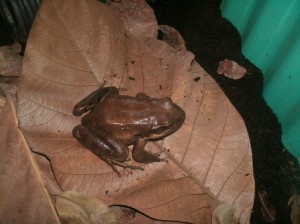
Every day in a building surrounded by lush green vegetation and tucked away at the back of the Botanic Gardens, Luke Harding and Machel Sulton perform a very important task.
Before entering the building, they step into a small concrete basin at the entrance filled with disinfectant. “You have to be decontaminated,” Harding explains.
Harding is from the Zoological Society of London and Sulton is an amphibian technician with the Forestry, Wildlife and Parks Division and they are about to change the water for 11 Crapauds being housed at the Dominican Mountain Chicken Project breeding facility.
The survival of the animals depends on the daily changing of the water and the two men can be described as foot soldiers in an important battle: the fight to save a national symbol, commonly known as the Mountain Chicken.
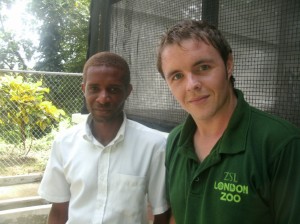
“The main function of this facility is to breed the frog, also known as the Mountain Chicken,” Sulton explains during a recent visit to the facility by Dominica News Online. “The long term goal is to breed them and release them back into the wild.”
The program is an important one because the Crapaud is a species in crisis which has seen better days. For decades it was considered a delicacy and was sought after and savored for its chicken-like flavor. It was considered Dominica’s national dish, forms part of the islands Coat-of-Arms and is used as a logo by several very important Dominican institutions, like the National Bank of Dominica.
But disaster struck in 2002 when Dominica experienced the first rapid decline of the amphibian’s population due to arrival on the island, of a deadly fungal disease called the Amphibian Chytrid. This disease wiped out at least 80 percent of the population within 18 months and the creature, whose croaks were heard in many parts of Dominica, hung on the brink of extinction and the Government of Dominica placed a ban on the hunting of the frog.
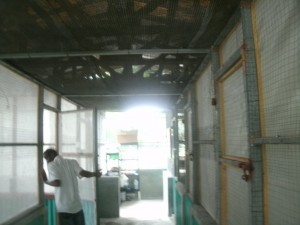
“The frogs in here we got them in the wild and were brought in sick,” Sulton remarks. “We treated them with the goal to have them breed and the tadpoles, which is the young frogs, will released into the wild.”
After decontaminating their shoes the two enter into the building with the DNO reporter in tow (whose shoes had to be decontaminated also). “Our general routine every day is to make sure the frogs have fresh water,” Harding states. “Everyday the frogs will defecate and sit in the water to bathe and so we have to make sure the frogs have fresh water. Amphibians need clean water because they absorb through the skin and dirty water poses a problem.”
The breeding facility contains four pens for the 11 frogs. The floor of each pen is made up of some of the type of materials one will find on the floor of the forest, closely imitating the real living environment of a Crapaud.

Harding and Sulton enter the pens with boots which are decontaminated after entering and exiting each pen. The DNO reporter was not allowed in the pens. “This is to minimize everything,” Hardings explains. “We never bring anything in and whatever is in the enclosure, we minimize the risk of bringing it out.”
But changing of the frog’s water is not the only daily routine for the two. “Every day we do visual checks on each of the frogs,” Harding says. “So you can tell a fat frog from a skinny frog … we can tell how healthy a frog is by looking at it.”
Every month the frogs at the facility get “a health check” to look for any clinical signs of illness and to swab for the presence of Amphibian Chytrid. “Then they are weighed to make sure we have happy and healthy frogs,” Harding states.
Then there is the feeding program. “Four times a week we come to the facility to feed the frogs at night because they tend to come out around dusk and at night they are very active,” he remarks.
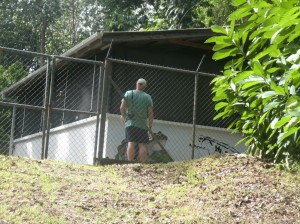
So what does a Crapaud eat? Well, food is not something the amphibians have to worry about because it is bred right there at the facility. “We currently have three species of crickets breeding here,” Harding explained. “And this takes just as much, if not more, time as caring for the frogs because a cricket is like an empty capsule and what we put in there nutritionally is what the frogs get … so we have to spend as much time looking after the crickets as the frogs.”
However, crickets are not the only food on the Crapaud’s menu. “We also got a cockroach species here and we supplement them with other things,” Harding says. “Occasionally we supplement them with millipedes and grubs (insect larva) which is especially good for fattening up a frog and they eat other things such as snails.”
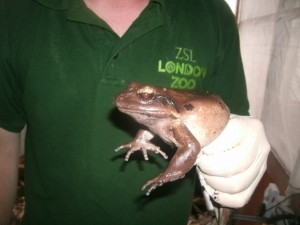
When it comes to breeding the Crapaud, the facility has more tricks up its sleeve. “Part of breeding amphibians is to replicate a natural cycle,” Harding states. “Right now is the rainy season which is a trigger for the Mountain Chicken to breed. All our enclosures are rigged up with a misting system and we can actually make it rain in every enclosure. We can regulate ‘the rain’ and vary it and make it look like a natural wet season.”
There is also a special UV lighting system which helps the frogs regulate their ‘day time’ and ‘night time’ at the facility.
The Dominican Mountain Chicken Project is a collaboration between European institutions and the government of Dominica.
Although the facility is not open to the public, there is a special outreach program to schools during which students are sensitized on the project and the importance of saving the Mountain Chicken.
Mountain Chicken has never been bred in captivity in Dominica and both Harding and Sulton say the process is a learning one.
And so every day both men religiously decontaminate their shoes and enter the breeding facility as they perform what they both describe as their “very important task.”
Click link below to visit the program’s Facebook page for more information.

A worthy effort. I am curious. Is the intention to release the tadpoles into the wild or raise them in captivity to increase the breading stock? And since the Crapaud was plentiful forty years ago wouldn’t it be important to examine what has changed environmentally here on the island? I am also curious. If changing the water is so important. Is this piped water that has been treated or pure water like the frogs would experienced in the wild. Or perhaps part of the problem is that unless the source of the is above the cultivation level most of our water is now contaminated by pesticide and chemical fertilizer run off.
Thanks to The European Communittee,The London Zoo Ological Society and MR Harding and MR Foulton for their great contribution in their efforts and interest in trying to save The MOUNTAN CHICKEN of DOMINICA. I wish success to all and look forward to the frogs breeding and young ones release into the wild.You are real patriots in trying to sustain nature.Thanks indeed.
MY apology, I should have checked the names of the two gentlemen before I posted my comment.Sorry MR SULTON.Thanks for active participation in this important programm.
These days everything making news? after the Frogs will be the Crabs. And then what? the Ants?
Good job son. I am very proud of you.
THANK YOU!
VERY interesting article….just wondering >>>could the public give a helping hand to donate cockroaches or snails or millipede to the facility??? when we find these insects we usually kill them whereas its another’s treasure?….just asking????
Thank you — both for the excellent project and article. Note the number of positive comments DNO, and keep bringing us interesting news like this occasionally.
Kudos to the guys on this project…though I have never and will never eat a crapaud, it is a part of our culture that I’m sure we’d like our generations to be privy to.
Is there space for internship? I am sure nationals would like to observe and train in the hope of furthuring studies in the much needed area od science.
Let’s hope those low flying planes that used to past over the island at night time and spray a few months/years back don’t fly over the botanic gardens.
It’s not only coastguard that has thermal night vision capabilities.
Thanks for the kind comments everyone and please if you like this article and want to help save the Crapaud from extinction on Domincia than continue to support our work. Please go and like our page Domincian Mountain Chicken Project on Facebook and follow more about the work and the frogs.
Thanks so much again and please remember it will take a contribution from everyone if we are going to save this incredible species and National Symbol.
Luke Harding
Luke are you aware of the breeding program of the Durrell Wildlife Conservation Trust in Jersey? Maybe they can offer some advice as to their breeding techniques. Here is an excerpt from the Wiki article on Leptodactylus fallax.
“Following the catastrophic volcanic eruptions on Montserrat, it became clear that dedicated conservation measures were needed if the Giant Ditch Frog was to be saved from extinction. In July 1999, the Durrell Wildlife Conservation Trust took six male and three female frogs to Jersey Zoo as part of a captive breeding study. Additional frogs have since been taken from disease-free areas, and the species has readily bred in captivity, with a number of other zoos achieving further breeding success. These captive frogs now form the basis of a safety-net population should the species become extinct in the wild. In addition, since January 1998, the Montserrat Forestry and Environment Division, in partnership with Fauna and Flora International, have been monitoring the species’ population.
Hunting of the Giant Ditch Frog was banned on Dominica in the late 1990s, although a three month open season was declared at the end of 2001, and hunting was not fully prohibited until 2003.Public awareness programmes have also been implemented to inform the Dominican public of the threats the mountain chicken faces and to try to discourage hunting.”
Great story!!! Kudos to the young men, the Forestry Division and Zoological Society of London for undertaking this important initiative. Hopefully our cherished crapaud species will return from near extinction.
Are there any nationals receiving training to do this work? Are those in the breeding program tolerant to the fungus?
In the 60’s and 70’s there were thousands of Crapauds in Dominica they were everywhere. We used to go out into the yard at night and look at them they would stop making noise if you got close.With their camouflage they were hard to see unless you shined a light on them their eyes would shine.
Very essential project. I am curious though that nothing is mentioned about irradication of the fungi amphibian Chytde. What have been done to destroy the fungi
This is a very informative and well written article. Thank you for sharing. Great work is being done by these young men and everyone involved in the project. Keep it up.
Just curious….has the National Bank of Dominica(NBD)aka “the Crapuad Bank” made any financial contribution towards this conservation programme aimed at rescuing the Crapaud from the brink of extension.
Correction….from the brink extinction
Very important question, seeing that the Crapaud “sits” so prominently on the bank’s logo (which they recently replaced on the front of the bank after several years).
I don’t understand. Do we want to save them or eat them. It’s our national dish, we should be catching and eating.
If you do not have them to catch you cannot eat them. You don’t need a PhD or are you just being sarcastic?
I D one zero T.In Order to eat them You need to have a healthy Population ,better than that is to appreciate them as a very rare specie and not eat them.
When was the project initiated and how many new frogs have been spawned?
Good work by these two gentlemen.
Thank you guys!
Great work. Keep it up guys.
Very encouraging programme. The dedication of Luke and Machel is remarkable. Hopefully, when the time comes to return them into the wilds, the environment will be acceptable.
Way to go guys, hopefully we can boost up the population of our national dish.
Interesting..good to know.
People really eat the frogs? I dont remember eating frogs as a child. ugg
I saw this at London Zoo a few weeks ago; I was so pleased I took a photo. We dat! Way to go ZSL!!
Great job guys!!! Interesting update on our crapaud.
You said that is is not open to the public but if I want to bring my students there for an organized visit. Can I? I mean besides just sensitizing them in the classroom.
I think that is something I could put in my Social Studies units for next school year.
Just asking
In the meantime keep up the good work.
Great job guys and the organizations involved…thanks for bringing the Crapeau back from almost extinction!
One thing for sure, now that i know wat it eats…Yuk…I definitely wont be eating one anytime sooe or in the future!
Time for a new National Dish – Callaloo anyone?
i actually read all the way to the bottom in less than no time… i scrolled down looking for more of the article… this goes to show a well written article does catch one’s attention. good job to the writer and Kudos to DNO on the interesting choice of topic.
To the men your efforts are highly appreciated. it’s nice to see that persons are still willing and have faith in the crapaud species.
Fantastic ! Hope the program survives .Let’s hope the crapaud comes back with a bang !
Informative, brilliant and hopeful for years of the survival of the crapaud. This is encouraging news. Thank you Mr Sulton and Harding.
DNO this was a GREAT article. Such a change from the usual…
Great job guys! I must commend the writer of this article, well-written. This piece of writing is one that will make readers who don’t enjoy reading long news items get to the end of the story….Thumbs up…
Great stuff!
Thanks DNO for bringing this information to light. I commend these two gentlemen on their commitment and dedication towards saving this national symbol.Great job..Thank You
Hats off to Sulton and Luke. Keep up the great work Sulton. Your dedication is endless and much appreciated. Many an evening I have witnessed this gentleman making his way to the facility to feed or bathe the frogs(his children) as I so jokingly refer to them.
Your efforts are very much appreciated.
Hats of Sulton & Luke. I must commend Sulton on his dedication. Sundays, holidays etc. he can be seen making his way to the facility to feed or bathe his “children”/frogs so to speak. Keep up the great work, we do appreciate it.
Thanks!!!!!!!
Great stuff
Thats good machel, so that’s what you do!! Keep it up k pal! blessingz…
All the best! Excellent work.
What a great job! and what a great team of dedicated and diligent individuals. Am intrigued by their job. Hats off to them and I wish team all the best. Is there anything the public can do to assist?
Keep up the good work guys. I am particularly impressed with the ongoing aggressive outreach programme. You probably need to ask members of the public who hear or see frogs to inform the Forestry & Wildlife Division or yourselves (Machel and Luke).
Dominicans need to be mindful of the symbolism of the Crapo a.k.a. Mountain Chicken. The frog features on Dominica’s coat-of-arms; it is the main element in the logo of our indigenous bank, i.e. the National Bank of Dominica; it features very prominently on the logo of the Dominica State College; we have local proverbs and Kweyol expressions “featuring” the Kwapo, e.g. ‘Kwapo pa ni bonda’
Mr.Sulton and Mr.Hardings thank you so much for your endless effort.Very tasty creature.Hope everyone who reads the article thank you for your endless effort.
This is some great work coming from caring, interested and optimistic men.
Kudos to you both,gentlemen,and may you be recognised with praise for such an important undertaking from a grateful nation.
They come out at dawn or dusk?
thank you Skerro